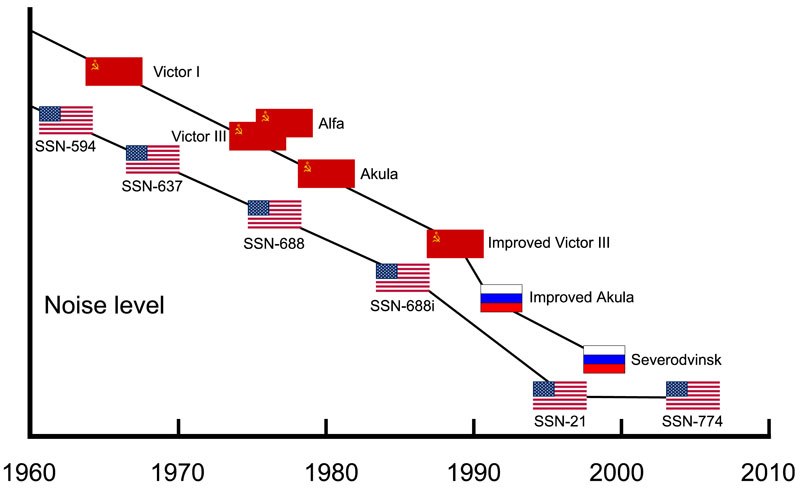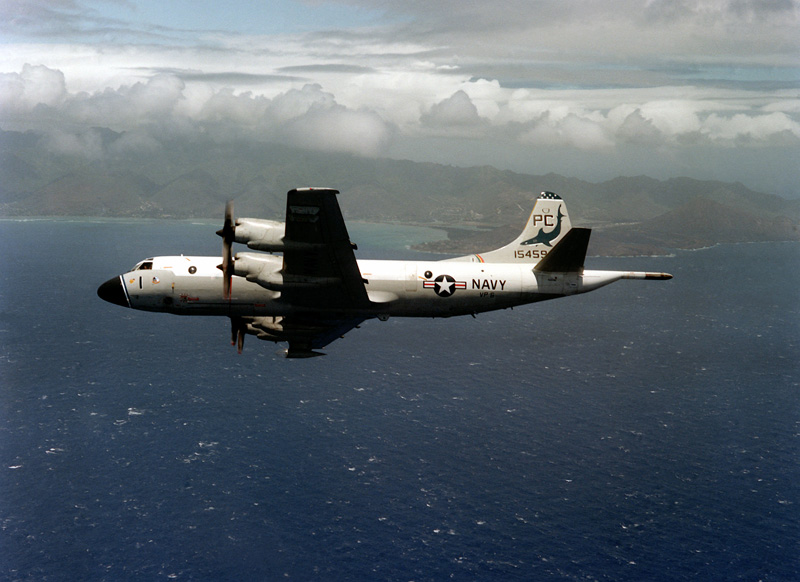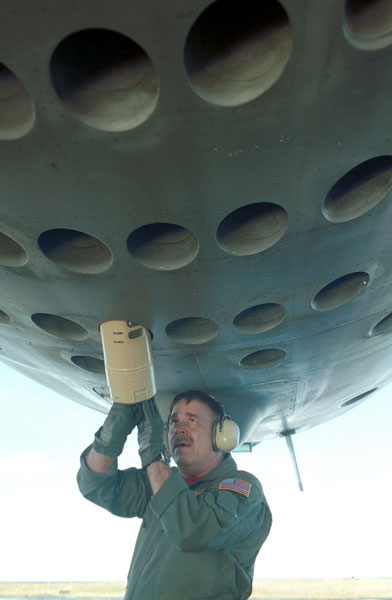|
Seawolf was the quietest submarine in the world. There are two primary ways submarines emit noise: machinery and propellers. Both had to be made as quiet as possible.
Operating a nuclear reactor requires lots of pumps for coolant and steam. Then, there are turbines, generators, and motors that turn the steam into electricity for both propulsion and to power virtually everything else onboard. All of these add up and make a sub noisy, which is why Nautilus was easy to hear and track. On Seawolf, all this equipment was mounted on rubber isolators, so the noise would not be transmitted to the hull, thus keeping the sounds inside.
When propellers spin under water, they create a sort of vacuum. This zone of low pressure actually causes the water to boil, and the boiling produces bubbles which create noise when they pop. This is called cavitation. On Seawolf, doubling the number of blades on the propeller and spinning it slower, cavitation was reduced, making the sub quieter.
The shape of the propeller blades was also extremely important. The manufacturing equipment and techniques were closely guarded secrets. Unfortunately, through espionage the Soviets learned this as well. Then, Toshiba sold them the same computer-controlled milling machines they sold the U.S. for shaping propeller blades.
Buzz recalled that Toshiba had so infuriated Congress that a group of lawmakers had bashed a Toshiba boombox with sledgehammers. On the floor, they voted to ban the importation of all Toshiba products for several years. But, the damage was already done.
The result was that Soviet submarines, while not as quiet as Seawolf, became quiet enough that SOSUS could no longer keep track of where they were. U.S. subs also had trouble tracking their prey. Something had to be done!

Submarine Noise Comparison
2010, by Voytek S, via Wikipedia
(click image to zoom)
The Navy had been developing a new ASW (anti-submarine warfare) system for its P-3 “Orion” patrol planes. Called MAD (magnetic anomaly detector), it can find a submerged submarine by looking for the disturbance the boat’s steel hull causes in the Earth’s magnetic field.
It’s like looking for a magnet with a compass. When the compass gets near the magnet, the pointer goes awry.
MAD has been around for a while. It was even used by both the U.S. and Japanese during World War II. This was a new variant, a 3rd generation detector, which could see deeper into the ocean than ever before. Most MAD systems have a “boom” which sticks out the back of the patrol aircraft, as far as possible from the engines to avoid electrical interference from the generators. The new boom was cryogenically cooled with liquid helium to −452 °F. That turned the detector into a superconductor, reducing signal losses by 80% and multiplying its efficiency by a factor of 5.
The Orion fitted with MAD-3 arrived on the East Coast from San Diego, where the Cal Tech scientists had been tweaking its software. The plane would be temporarily stationed in the U.S. Coast Guard section of Joint Base Cape Cod where it could be hangared out of view from the prying eyes of Russian and Chinese satellites. Orions have many systems that are common to USCG aircraft, so “coasties” could help with maintenance if required.
To test the new ASW capability, the Navy set up a drill, pitting the virgin MAD-3 system against its newest nuclear attack submarine. Seawolf was given two days’ head start, but it was confined to a patrol area of only 1,000 square miles, almost the size of Rhode Island, the smallest state in the U.S. It was a box roughly 32 miles on each side.

U.S. Navy Lockheed P-3B Orion with MAD Boom
U.S. Navy photo
(click image to zoom)
The Lockheed P-3 Orion is a large, 4-engine turboprop patrol bomber. It is 116’ 10” long with a wingspan of 99’ 8.” It was developed from the company’s L-188 “Electra” civilian passenger plane which was used by several U.S. airlines in the 1960’s. The prototype first flew on 19 August 1958, and newer models are still in service today.
The Orion has an internal bomb bay, typically loaded with conventional Mark 50 or Mark 46 torpedoes, but it can also carry nuclear weapons of several types. It also has 10 “hardpoints” which can carry additional weapons such as missiles or bombs under the wings. It can also carry target drones. The main strengths of the Orion are its range of 2,380 nautical miles and long endurance of 16 hours.
At first, the Orion tried using sonobuoys to find Seawolf. This is a miniature sonar system that can be dispensed out of the bottom of the ASW airplane. They can simply listen passively or go active and start to “ping” when they hit the water, floating on the surface, usually as part of an array to make triangulation possible.

Loading Sonobuoy into Launcher on P-3 Orion
U.S. Navy photo
(click image to zoom)
The ASW technicians divided the test area into separate zones. Then they dropped a single sonobuoy in the center of each zone. That way they would have had a fairly good chance of finding their prey, and hopefully triangulate a position for another tighter array to nail the box shut. At least that was the plan they started with.
The only contacts found by the first array dropped were “biologics” ... a school of dolphins and one small whale. There were no sub-surface man-made noises on the scope. Without a good lead, they could exhaust their supply of sonobuoys in no time, so it was time to fly a MAD grid.
Starting at the northwest corner, they flew back and forth the width of the grid, dropping one half mile south with each pass. Flying low at 220 knots, it took the P-3 all of 8 hours to cover the entire grid.
Seawolf’s state-of-the-art sonar was tracking the Orion overhead as the sound waves from the plane’s noisy engines impacted the surface of the water. Buzz knew exactly what was going on and basically read the minds of the ASW team.
So, when the Orion got half way down the grid and was on the far east side of the box about to turn west again, Buzz scooted Seawolf up along the western edge into the northern part of the test area that had already been searched!
This scheme worked to the sub’s advantage, until the Orion made an unexpected diagonal pass near the end of the third day in the exercise, and then it almost accidentally found its prey. The Orion simulated a depth charge attack by dropping a few hand grenade-sized signal charges directly on the sub’s position. Following the rules of engagement, Seawolf was forced to surface and the game was over.
Buzz Nelson was very disappointed. His brand new sub was not as stealthy as he thought. To rub salt in an open wound, he also lost a gentlemen’s bet and now owed the Orion’s pilot and crew of 12 a round of beers.
|